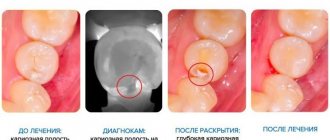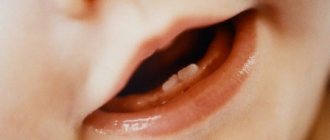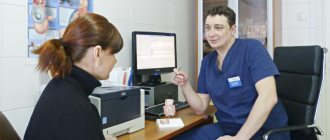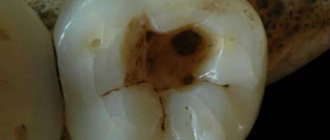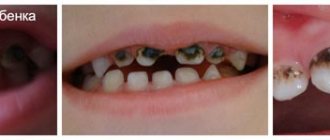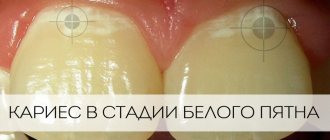What is Priestley plaque on teeth?
This is a dental problem that occurs in children. In this condition, deposits are found on the enamel of the teeth. Dark plaque on a child’s teeth can be black or brown, sometimes with a light or pearlescent tint. As a rule, it is located as a thin border along the lower edge of the teeth closer to the gums. But plaque can also cover a large area of the tooth or look like a small spot on the enamel. Most often, dark deposits appear on the inside of the teeth, less often in the interdental space or on the outer surface of the teeth.
Photo courtesy of InWhite Medical Clinic
Tooth pigmentation - symptoms and treatment
A doctor can make a diagnosis of “teeth pigmentation” by collecting all the necessary data after a survey and examination. If necessary, additional studies are performed.
In modern medicine, there are not many methods for diagnosing tooth pigmentation, so choosing the right one is not difficult. These include:
- visual inspection of clinical manifestations;
- radiography - allows you to evaluate the internal structure of the tooth and identify deviations;
- computed tomography (CT) is a fairly modern research method that is beneficial for both the doctor and the patient (the doctor receives a higher quality image, and the patient receives approximately 90% less radiation); allows you to study the image in 3D format and monitor the dynamics of treatment;
- microscopy - magnifies the area under consideration approximately 25 times, makes it possible to study the structure of the enamel and the extent of the lesion;
- rheodentography - allows you to determine the functional abilities of the pulp, as well as assess the depth of the lesion;
- electroodontodiagnosis is a method of studying the condition of the pulp and periodontium (soft tissues surrounding the root of the tooth) using a dosed electric current that affects the nerve without damaging the tissue membrane of the pulp [8][9].
As a rule, to diagnose ordinary pigmentation, it is enough only to collect complaints, an anamnesis (history of the disease) and a visual examination. Doctors resort to more serious studies, such as CT scanning and a microscope, in case of deeper lesions of the dental cavity and periodontium.
To choose the right treatment method, it is very important to establish a correct diagnosis and not confuse a pigment spot with caries. The latter, unlike dark pigmentation, has a cavity bottom that is not only dark, but also loose.
Superficial caries must also be differentiated from a whole group of non-carious tooth lesions, such as enamel hypoplasia, fluorosis, wedge-shaped defect, erosion and necrosis of hard dental tissues.
With caries, the spot is most often a single one. It is localized in the grooves on the chewing surface or one of the contact surfaces (between the teeth), less often on the neck of the tooth. With hypoplasia and fluorosis, the spots are multiple and localized in places atypical for caries: areas of the labial (cheek) and lingual surface of the tooth crowns.
Spots with hypoplasia are usually white with clear boundaries and have a smooth and shiny surface. They are located at the same level of the crowns of several symmetrically located teeth.
How to detect dark plaque in time
- regularly examine the child’s oral cavity independently;
- do not postpone scheduled visits to the dentist.
It must be taken into account that Priestley plaque on the teeth often accumulates slowly, which is why the child gets used to the stains on the enamel and does not tell his parents about them. Darkening of teeth can occur quickly, literally overnight. Reactive appearance most often occurs during illness, accompanied by intoxication, dehydration and increased body temperature. This is due to the fact that the child’s body reacts sharply to various changes in diet, the functioning of internal organs and in external conditions.
Deposits most often occur at the age of 2-3 years. However, they can also appear on the very first milk teeth of a one-year-old child. Or it could affect the baby teeth of a younger teenager who haven’t had time to change. The darkening may also spread to permanent teeth.
Prevention of dental plaque in children
Prevention of dental diseases should begin with the appearance of the first milk teeth. The following recommendations must be followed:
- brush the newborn’s teeth from the moment of teething using a special silicone fingertip;
- by the age of 2-3 years, accustom the child to cleaning the oral cavity independently in the morning and evening;
- change your baby’s toothbrush every month, buy hygiene products intended for children of the appropriate age;
- Bring your child for a preventive examination to the dentist every 4 months, even if there is no plaque or other symptoms;
- limit the consumption of sweets, include healthy foods without fast carbohydrates and with minerals in the children's menu.
The baby may also be bothered by other symptoms that he cannot tell an adult about. Therefore, bring him for examination, regardless of what color plaque has formed on his teeth.
Why does a child have black plaque on his teeth?
The main problem with the appearance of Priestley plaque on teeth is not that it causes bad breath, looks unsightly, or cannot be removed independently without the help of a hygienist. Priestley's plaque is a signal that something has changed in the child's body, due to which non-dangerous bacteria began to actively multiply, creating deposits. And for high-quality treatment and prevention of the development of diseases, it is necessary to find out why black plaque forms on the teeth, the reasons for the appearance of beneficial living conditions for bacteria.
Possible causes of plaque:
➢
diabetes;
➢
genetic feature or hereditary predisposition;
➢
thyroid diseases;
➢
incorrectly selected hygiene products;
➢
parasite infection.
Dysbacteriosis.
Disruption of the gastrointestinal tract can occur due to malnutrition, food poisoning, immaturity of the digestive system, taking antibiotics or chronic diseases of the stomach, liver, and intestines.
Caries.
Due to the fact that parents usually do not brush their baby’s first teeth, yellow plaque begins to accumulate on the enamel, which over time can cause caries. Irregular or insufficiently high-quality tooth brushing by the child himself also leads to the formation of caries. Carious lesions create a favorable environment for the growth of bacteria, which causes Priestley plaque to appear on baby teeth.
Dehydration.
Due to dehydration due to various reasons, the body cannot produce enough saliva to wash the teeth and remove food particles. Because of this, bacteria begin to multiply faster, and a dark plaque forms on the child’s teeth. Therefore, it is important to ensure that your baby gets enough fluids, especially in hot weather or during illness.
Hypoplasia of tooth enamel.
Some children have underdeveloped top layer of enamel. It is weakened and unable to perform a protective function.
Disorders of dental development in the prenatal period.
Dental buds may be damaged during development due to viral infections suffered by the mother, calcium deficiency, iron deficiency, or taking certain medications.
Improper functioning of the immune system.
Malfunctions in the immune system can affect the body's ability to suppress bacterial activity.
Malocclusion.
If a child has a malocclusion, the load on the jaw when chewing is distributed unevenly, which is why some of the teeth receive increased load, but are cleansed with solid food: carrots, apples. And unused teeth become covered with plaque.
Tooth enamel: general characteristics and properties
This is the hardest and most durable tissue in our body, its thickness on the outer surface reaches almost 2 mm. It consists of many layers formed at various stages of mineralization and has a crystalline structure. The chemical composition is represented predominantly by apatites, calcium and phosphorus predominate from inorganic compounds, and proteins, lipids and carbohydrates from organic compounds.
The main function is to protect dentin from external factors: mechanical, chemical and temperature stimuli. Thanks exclusively to this tissue, teeth can fulfill their main purpose - grinding and chewing food.
Despite its extraordinary strength, enamel is permeable to water and many organic and inorganic substances contained in saliva. It has been found that the degree of permeability for much-needed connections depends on several factors. If we talk about temporary occlusion, this is:
- condition of the oral cavity;
- nutritional features;
- long-term treatment with certain medications (in particular, tetracycline antibiotics);
- features of intrauterine development.
Enamel maturation
The composition of the protective tissue covering dentin is constantly changing, which is associated with age-related characteristics. Throughout the year after teething, there is an active accumulation of calcium and phosphorus, and during this period it is extremely important to receive all the necessary elements with food or multivitamin preparations. It has been proven that a sufficient content of microelements prevents the development of caries.
Diagnosis of Priestley plaque on teeth
If darkening is detected on the enamel of a child’s teeth, you must contact a dental clinic.
The specialist will:
✔
inspection;
✔
laser diagnostics to determine the depth and size of the lesion;
✔
anamnesis collection.
After a conversation with the parent and child and collecting an anamnesis, the pediatric dentist will immediately prescribe treatment or conduct an additional examination. You should not neglect it - it is important for a specialist to find out why the child has black plaque on his teeth. Only after this will he be able to provide quality treatment.
Caries
Children at an early age are characterized by the so-called “bottle caries”, which develops on several teeth at once due to the habit of falling asleep with a bottle of sweet nutritional mixture. Such food is to the taste not only of children, but also of microorganisms that rapidly multiply in the oral cavity in the presence of a carbohydrate substrate.
The hard dental tissues of toddlers are poorly mineralized, so when the surface layers of enamel are destroyed, they are quickly saturated with food coloring, acquiring a dark and sometimes even black color. Often, with a sufficient content of calcium salts in food, the carious process is stopped, the dentin becomes denser, but the dark color of the eroded surface remains.
With a lack of calcium, the carious process covers a significant area of the tooth surface, leading to its rapid destruction. If it is not possible to close large defects with a filling, then the dentist stops the destructive phenomenon using the silvering method - the enamel is treated with silver nitrate, which, when combined with protein molecules, forms an antimicrobial protective film. The disadvantage of this method is the blackening of the damaged areas, so the method is used on the front teeth only in young children.
Additional protective measures for Priestley's raid
It is possible that Priestley's plaque on the teeth appeared due to an infection and, as a result, a temporary deterioration in the functioning of the immune system. But it is necessary to make sure that there are no serious and dangerous deviations in the child’s health. Therefore, if dental plaque is detected, the dentist will recommend taking additional measures:
- get tested for the presence of parasites in the body;
- consult a gastroenterologist;
- take tests to check the level of iron and calcium in the body;
- check your blood sugar levels.
These measures will help identify the problems that are causing plaque to form on your teeth.
Black spots
Tooth degradation of this nature can have several causes. One of them is Priestley's plaque , most often caused by disturbances in the microflora of the children's intestines. As a result, both baby and molar teeth are destroyed by bacteria. The disease can only be treated with medication.
Black spots can also be caused by the development of caries. Blackening of teeth is often a consequence of a lack of calcium in the body. For prevention, you need to reduce the amount of sweets you consume.
In addition, you can increase calcium levels by giving your child more milk and using vitamin complexes prescribed by your dentist.
Much less often, but still possible, this pathology can be inherited from parents. Therefore, the child must have personal cutlery (at least a spoon and fork).
How to remove black plaque on teeth
It is impossible to remove dental plaque at home. Moreover, the use of abrasive agents and intense exposure to teeth with a brush can cause an increase in dental problems: thinning or damage to the enamel, trauma to the gums or mucous membrane.
Priestley's plaque on children's teeth can only be removed in a well-equipped dental clinic. The specialist will:
- professional teeth cleaning;
- If necessary, treat the teeth with a remineralizing composition.
If plaque formation is caused by dental problems, additional treatment may be prescribed, including bite correction.
The doctor will also select a home hygiene kit that is ideal for the child: a toothbrush of the correct shape and hardness, toothpaste with the optimal composition, and mouth rinse. Additionally, the hygienist will teach the child how to brush their teeth correctly and will talk about the need for quality oral care.
Taking into account the causes of the disease, the dentist may prescribe additional treatment measures, for example, recommend dietary supplements, dietary nutrition, avoidance of drinks and foods with dyes that affect the color of the enamel.
Prevention measures
While it can be quite difficult to correct the problem of blackened enamel, preventing such a phenomenon is not particularly difficult. But for this, parents will have to do serious work with the child, namely, accustom him to daily brushing his teeth twice a day, teach him the correct technique for cleaning the enamel from plaque and bacteria, and also, if possible, exclude from his diet foods high in sugar and fast foods. carbohydrates. In addition, you should carefully choose hygiene products, because toothpaste for older children is not suitable for a 3-year-old child. Also, do not forget to change your brush regularly, preferably every 2-3 months.
Maintaining oral hygiene will help reduce the risk of problems
The most important condition is a systematic visit to a specialist for the purpose of undergoing preventive examinations. Very often, dental diseases are asymptomatic at first, and then it is almost impossible to detect the problem on your own. In such a situation, only a good experienced specialist will be able to recognize suspicious changes and conduct a more thorough diagnosis. This will allow you to make a correct diagnosis in time and prescribe timely treatment.
- Knappvost A. The influence of fluoride ions on the physiological and pathological metabolism of calcium: caries, osteoporosis, atherosclerosis, 2000.
How to deal with little black caries
To prevent the cavity from turning into a large hole, you need to perform remineralization in the dentist's office. To do this, the doctor applies a special composition to the teeth, which quickly penetrates into the deep layers of the damaged units and, as it were, nourishes them from the inside. As a result, the teeth become stronger and more durable, and the rapid spread of the carious process is temporarily blocked.
In case of serious damage, the dentist can give the client a mouth guard and a special remineralizing composition. You need to use all this at night - before going to bed, put the product in a mouth guard and put it on your teeth. Remove in the morning. Repeat the procedure the number of times indicated by the doctor.
Priestley's Raid
Having noticed that the child’s front tooth has darkened, parents take a closer look at other units and may find that dark plaque covers the entire dentition in the area adjacent to the gingival margin.
This is what Priestley's plaque looks like - a bacterial film formed due to dysbacteriosis in combination with lack of dental care. The film stains and becomes darker over time. It is not possible to remove thick plaque on your own, but the dentists at the Shifa clinic have all the necessary equipment to use painless techniques to rid the child’s teeth of staining.
In this case, it would not hurt to consult a gastroenterologist and endocrinologist for early detection of systemic general pathology.
Irreversible change in enamel color
It also happens that after erupting a tooth immediately stands out in an unusual color - from purple or green to different shades of brown. Parents cannot even imagine why their child’s tooth has darkened. The main reasons for this condition may be the following:
- Taking tetracycline drugs by the mother during pregnancy or treating the baby with tetracycline without the knowledge of the doctor.
- Hemolytic disease of newborns without adequate correction.
- Fluorosis. In this case, the teeth become mottled with dark spots on the glossy white enamel. The disease develops when drinking water with a high concentration of fluoride is consumed during the formation of dental tissues. It's not dangerous, but not aesthetically pleasing.
Teeth with such types of pathology remain multi-colored until the bite changes.
DIAGNOSTICS
Priestley's plaque itself is not dangerous to the body, but dark spots can also occur for other reasons. Therefore, you should always rule out risks and check with a dentist.
In cases where a stain appears on a tooth, diagnostics is carried out using a laser. This helps the specialist determine how deep the caries has spread, as well as its stage. After diagnosis, individual treatment is prescribed based on the data obtained.
If the dark plaque was not caused by caries, the specialist will prescribe additional tests that will identify the problem.
Injury
Children's outdoor games are accompanied by injuries that do not immediately manifest themselves. When a tooth is bruised, the thin blood vessels entering through the root apex may rupture, forming a hematoma in the pulp chamber. The crown part of the tooth remains intact, but changes color. If a child’s tooth has darkened after a blow, it is necessary to see a dentist for treatment. Otherwise, inflammation of the baby tooth can affect the development of the permanent follicle, which is located deep in the bone.
Dental specialists will tell you what to do if a child’s tooth has darkened. To detect hidden problems and eliminate them in a timely manner, it is necessary to undergo regular preventive examinations with a dentist. Doctors at the Shifa clinic will teach the child the rules of hygienic care and select a toothbrush and toothpaste appropriate for his age. If you have darkened teeth, our specialists will create a personalized program for restoring dental aesthetics. The clinic has all the necessary equipment to make your child’s teeth beautiful and healthy.


